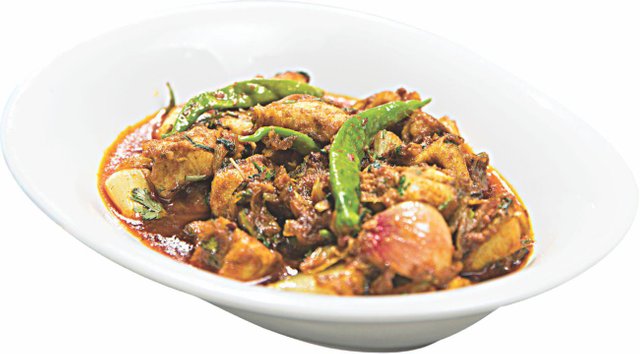Food in Bangladesh

Bengali cuisine is considered easy to cook, with simple spices, and Bengalis take much pride in their food. Ask any Bengali on their cuisine, and invariably the description will include bhaat-macch (fish & rice), bhorta (mashed preparations), daal (lentil soup), shaak (leafy vegetables), narikel bata (coconut paste), shorshe-bata (mustard paste), posto-bata (poppy seed paste), shorsher tel (mustard oil), and panchphoron (five spices). Panchphoron is the only concoction of spices that Bengalis use to flavour their curries. No other culture in the world uses this blend in their cuisine.
I believe, spices were an expensive commodity during ancient times and were not yet extensively cultivated in Bengal. Thus five aromatic spices i.e. nigella, fenugreek, cumin, black mustard seeds & radhuni (Carumroxburghianum) were blended together to make panchphoron, which was sparingly used to bring aroma to the curries. These are the basic ingredients of Bengali cuisine.
Upon invitation to a Bengali household the hostess would prepare a feast consisting of a variety of fishes, prawns, meat and vegetables, like balashi maccher chorcori, pabda macch, rui macch kalia, tel koi, chingri mach er malai curry, bhapa eelish, sorshe elish , shak chingri, different kinds of veg and non veg bharta (mashed preparations), eelish pulao, chitol macch er kofta etc. Bengalis are known to be very hospitable, especially with food. The hostess will keep replenishing your plate till you are bursting at the seams, starting with bitter gourd as an appetizer, bhaja (sautéed veggies), bhorta, shaak followed by macch, goshto, daal and chutney, as the main and ending with doi (yougurt), roshgolla (sweets) or payesh as dessert.
In fact, if you want to know about a country's history, you do not need to buy a history book just buy a cook book. Ninety percent of the Bengalis in Bangladesh are Muslim and their cuisine reflects the influence of the Mughals in dishes like kacchi birani, morog polao, lamb roast, murog musallam, glasi, korma, tehari, bakhar khani, halua, mishti zarda, rezala, shemai, mishti, etc. Mughlai food is very rich, unlike the Bengali staple, and is partaken only on special occasions or when entertaining.
Bangladesh is called the land of rivers, as almost 300 rivers and their tributaries crisscross through the country. The out flow of water from Bangladesh is the highest in the world, next only to those of the Amazon and the Congo systems. Bangladesh has three great rivers, the Ganges, the Brahmaputra and the Meghna. Thus, we have no dearth of sweet water fish. These days Bangladesh ranks fourth in fish farming. Each year a large number of Hilsha fish are caught in the Padma-Meghna-Jamuna delta, which ends into the Bay of Bengal. It is a marine fish but comes back to the rivers to lay its eggs in large rivers. After birth the young Hilsha (known as jatka) then swims back to the sea. They are caught before they swim to the sea as the ocean Hilsha are not considered to be as tasty as those caught from the river. Hilsha (a.k.a. Ilish) is full of tiny bones which require trained/fine hands on experience. The Hilsha of the Padma River is known to be the tastiest variety and is highly sought after among the Bengalis.
My experiences were the essence of what's now referred to me as "culinary tourism,'' — getting to know countries and cultures through food. These days, it is big business. According to many companies researching and reporting on the travel industry, culinary or food tourism is one of the top trends defining travel for 2013 and one of the fastest growing areas of specialty travel. In other words, gourmet getaways are as hot as Sriracha (hot chili sauce).
Some of the dishes which I tasted on my travels were unfamiliar to me, but the people who prepared and served me were warm, friendly and welcoming and also very proud of their creations. Eating their food taught me more about their locales. While I visited most of Bangladesh, I observed today's travelers to be hungry for authentic, hands-on experiences like unique accommodations, local guides, visit to local farms, and interaction with the people who produce the food. I did a lot of research and discovered that food has always been a core element of an 'authentic' experience. I focus on the culture and traditions of food in different locations and made time for spontaneous interactions with the people who know those foods best.
The places I have visited are overflowing with numerous markets and restaurants but finding them on your own can be a monumental task. So, go to a market that specialises in a particular ethnic food, then go to a local restaurant for a cooking class and eat the local food and lend an ear to their family's tales. Wherever you travel, take a food tour as soon as you arrive there, it will help you to get a better sense of that locality. Then you won't be at the mercy of the hotel concierge who in all likelihood will send you to the touristy restaurants rather than the places where local people gather. Sharing food is more than a tasty adventure. You can have absolutely no connection with local strangers, but the minute you start talking about food those barriers are broken. People say it's like traveling abroad in an afternoon but I say “food brings people together.”
source: the daily star